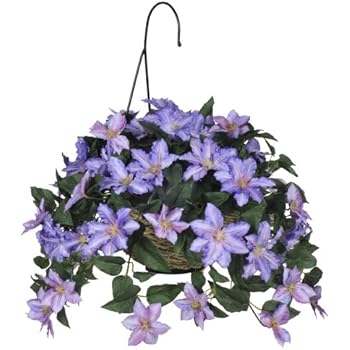Clematis, known for its stunning and varied blooms, is a favorite among gardeners who seek to add a splash of color to their landscapes. However, to achieve the most spectacular flowers, it is essential to provide the right nutrients through fertilizer. In this article, we will explore the best fertilizer choices for clematis, how to apply them, and tips for maintaining healthy plants that yield vibrant blooms.
Understanding Clematis Nutrition Needs

Clematis is a diverse genus with over 300 species, each with its unique flowering patterns and nutritional needs. However, most clematis plants thrive under similar conditions. Understanding these needs is the first step in selecting the right fertilizer.
- Soil Quality: Clematis prefer well-draining soil that is rich in organic matter.
- pH Level: The ideal pH for clematis ranges from 6.0 to 8.0, slightly acidic to neutral.
- Nutrient Requirements: Clematis plants require a balanced supply of nitrogen (N), phosphorus (P), and potassium (K), often referred to as NPK.
While nitrogen promotes leafy growth, phosphorus is crucial for root development and flowering, and potassium helps with overall plant health and disease resistance.
Top Fertilizer Choices for Clematis

When it comes to fertilizing clematis, several options stand out as particularly effective. Each type has its pros and cons, which we will explore below.
1. Granular Fertilizers
Granular fertilizers are a popular choice for clematis because they release nutrients slowly over time. Here are some top options:
- Osmocote Flower & Vegetable: This slow-release fertilizer is perfect for clematis. It contains a balanced NPK ratio and is designed to promote blooming and overall plant health.
- Miracle-Gro Shake ‘n Feed: This is another great slow-release fertilizer that includes micronutrients. Its NPK ratio of 15-30-15 is especially beneficial for flowering plants.
2. Liquid Fertilizers

Liquid fertilizers are ideal for quick nutrient absorption and can be used during the growing season for immediate impact.
- Miracle-Gro Liquid All Purpose: This concentrated liquid fertilizer can be diluted with water, allowing for easy application. Its balanced NPK ratio supports overall growth.
- Fish Emulsion: An organic option, fish emulsion is rich in nitrogen and trace elements, promoting healthy foliage and blooms.
3. Organic Fertilizers

For environmentally conscious gardeners, organic fertilizers provide a sustainable alternative. These options may take longer to show results but promote long-term soil health.
- Compost: Well-rotted compost can enhance soil structure and fertility, providing a slow-release source of nutrients.
- Bone Meal: High in phosphorus, bone meal is excellent for root and bloom development, making it a great addition to the planting hole.
How to Apply Fertilizer
Application techniques can significantly affect the efficacy of the fertilizer. Here are some guidelines on how to apply fertilizers effectively:
- Timing: Fertilize clematis in early spring as new growth begins, and again after the first bloom cycle for continued flowering.
- Method: For granular fertilizers, sprinkle them around the base of the plant and lightly work them into the soil. For liquid fertilizers, apply them directly to the soil near the roots.
- Watering: Always water your clematis thoroughly after applying fertilizer to help the nutrients penetrate the soil.
Case Studies: Successful Clematis Growth

Research and anecdotal evidence demonstrate the effectiveness of proper fertilization on clematis growth. For instance, a study conducted by the American Society for Horticultural Science showed that clematis plants receiving balanced fertilizer produced 30% more blooms than those that did not.
Additionally, many experienced gardeners share their success stories online. One gardener reported that switching to a slow-release organic fertilizer led to larger, more vibrant flowers and healthier foliage. This case highlights the importance of tailoring fertilizer choices to individual plant needs.
Common Mistakes to Avoid
While feeding clematis may seem straightforward, several common mistakes can hinder plant growth:
- Over-fertilization: Too much fertilizer can lead to excessive leaf growth at the expense of blooms. Stick to recommended dosages.
- Ignoring Soil Quality: Fertilizers are not a substitute for good soil. Ensure your clematis is planted in nutrient-rich, well-draining soil.
- Fertilizing at the Wrong Time: Fertilizing too late in the season can encourage new growth that won’t have time to harden before winter.
Tips for Maintaining Healthy Clematis

In addition to proper fertilization, here are some tips to ensure your clematis thrives:
- Mulching: Applying a layer of organic mulch around the base can help retain moisture and suppress weeds.
- Pruning: Regular pruning promotes healthy growth and encourages more blooms. The timing and technique depend on the clematis species.
- Watering: Clematis prefer consistent moisture, so ensure they receive adequate water, especially during dry spells.
Clematis can transform any garden into a vibrant display of color when properly nurtured. Selecting the right fertilizer, timing its application, and avoiding common mistakes are crucial steps in achieving lush, abundant blooms. Whether you choose granular, liquid, or organic fertilizers, understanding your clematis’s specific needs will lead to healthier plants and more impressive flowers. Remember, the key to a thriving clematis is a balanced approach to nutrition and care. With the insights provided in this article, you are now equipped to make informed decisions that will enhance your clematis garden for years to come.


